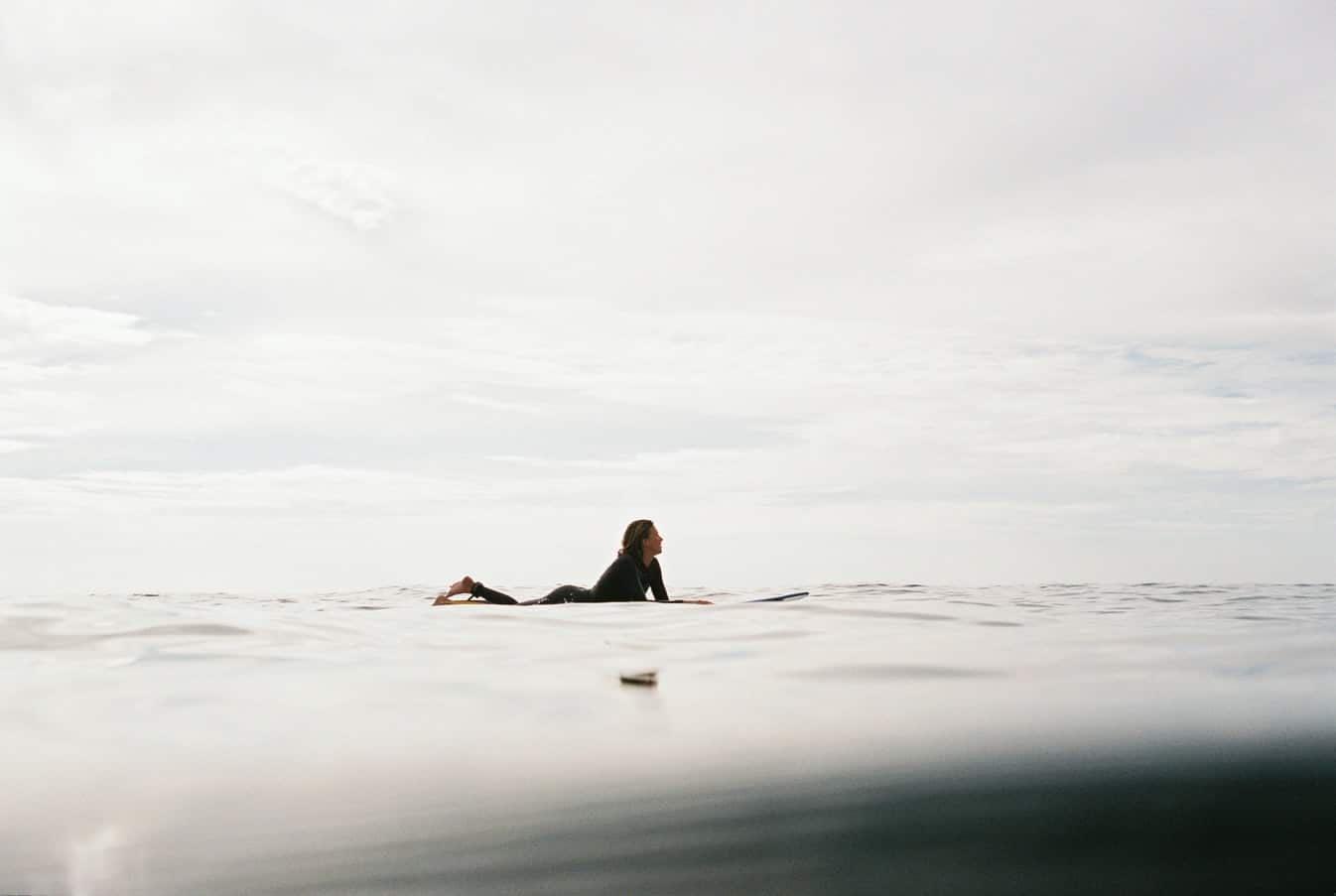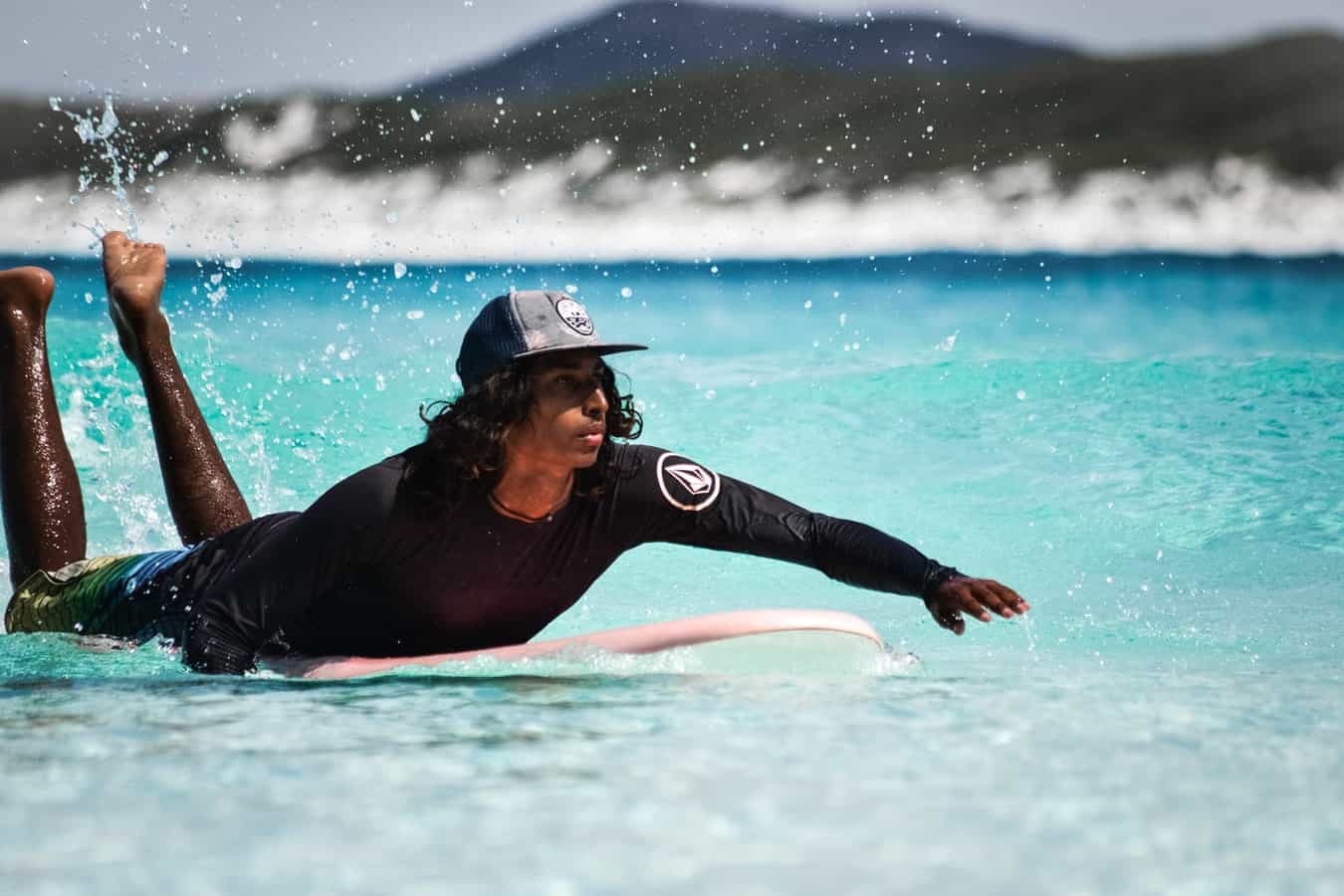Longboards range in size anywhere from 8 feet on the shorter end to 12 feet or longer. Longboards are called “longboards” because they are larger than standard surfboards. Longboards allow you to surf any kind of wave including the 30 to 50-foot waves encountered in big wave surfing. Most of the time you’ll spend surfing is paddling. It’s important to position yourself properly on the board so that you’ll move quickly and effectively without expending too much energy.
So where are you supposed to lay on a longboard? Position yourself in the middle of the board, with your chest just above the center of the board. If you lay too far back towards the tail of the board, this will cause the nose to rise and you’ll paddle harder. Positioning yourself too far up the longboard will cause the nose to sink, making water splash up onto the board.
The best way to determine your exact laying position on a longboard is to take the board out into the ocean and paddle, shifting your body up and down the board. The board rests just above the water’s surface; when the nose dips just under the ripples in the water, you’re in the optimum place on the board for paddling. If your position generates a lot of foam, then you’ll need to adjust.
You want to maintain the level aspect of the longboard on the water, with you resting on it and paddling. You can move back and forth as you paddle, to adapt to calmer or more turbulent waters. You never want the nose or the tail of the board to get underneath the sea.
What Is The Best Way To Paddle A Longboard?
If you’re loving being out on the water, you’ll want to keep your strength at a maximum to stay there. Most of the time you’re out there, you’re paddling, and paddling requires a lot of upper body strength. Even if one is in fantastic physical shape, too much paddling wears out even the best surfers. Budget your energy, because you will need to paddle through breaks, against the current, and push up off the board to catch a wave.
Longboards are heavier and longer than other surfboards, so their surface area is also greater. The board itself tends to move upward, and you want to encourage its natural movement, but you’ll need to harness it through good positioning.
If done right, you’ll notice how much easier it is to paddle on a longboard. It’s also easier to line up for waves than shortboards and easier to push through broken waves due to the weight and size of longboards.
Surfers with more experience learn to perform turtle rolls on longboards. A turtle roll, which is gripping the sides of the board and flipping it over, can only be done on a longboard. Another more advanced technique for getting around waves while paddling is to duck dive, that is, moving the board underwater and under the wave, surfacing again on the other side to resume paddling. However, dusk dives are more difficult to do on a longboard due to the board’s size and weight.
The best way to paddle on a longboard is to swim using the “S” stroke, developed by swimmers to help them gain speed and efficiency in their strokes. Here is how to paddle with an S stroke.
- Cup your hands slightly, fingers spread apart.
- Slice your hands through the water, your thumb moving first under the surface.
- As you start your motion, pull away from your body outwards.
- For the second part of the stroke, pull your arms in.
- On the last part of the S stroke, pull out again.
This zigzag movement of the arms is more effective because different muscles are utilized when the arms are in than when they stroke away from the body, so it’s a great way to paddle fast while conserving energy.
When paddling, your feet are lifted off the board and pointing in the direction of the sky. When the wave is about to pass, stop the S stroke and paddle with both arms at full force at the same time.
You can compare paddling with the S stroke to freestyle swimming, and paddling with both hands at once to swimming the butterfly.
Keep checking the nose of the longboard to confirm that it rests about an inch above the water’s surface. You’re doing it right when the nose is here.
The more you paddle and combat waves you encounter, the better you’ll know what your optimum position is on the longboard. It takes time and practice, but once you have it, you’ll use less energy and get more accomplished.
What Is The Best Way To Push Through Waves?
When you surf, it’s rare to paddle through calm, restful waters. When waves are nearby, the rules of hydrodynamics dictate that there will be primary waves (the ones you can ride), as well as smaller, broken waves (the ones you want to paddle through).
When you encounter a whitewater wave, paddle harder (both arms at once) and prepare to push up off the board. Paddling then pushing up, in succession, will become second nature once you’ve tried it a few times.
You can do this in areas where there is flat water when you’re perpendicular (90 degrees) to the wave.
Approach a rolling wave, and about 6 feet before you impact with the wave, paddle towards the broken wave.
Move your legs together until they’re touching. Move up your feet so your toes rest on the tail of the surfboard.
Move your hands to the sides of the board, hands even with your upper chest muscles. Now, push your body up and arch it back, and let the whitewater move over the surface of the board below your body.
After the wave passes, paddle to the endpoint of the whitewater wave (also called out-the-back).
Don’t ever stop and wait for the wave to reach you. Your forward motion is your momentum, and this allows you to pass through the wave quickly and with less resistance. If you stop, it will be harder to get through the wave without doing a duck dive or a turtle roll.

What Forces Does A Surfer Works Contend With In The Water?
A great way to get better at paddling faster is to understand how your longboard works, and the natural forces that operate on it.
3 forces operate around and on the surfboard, and the surfer and when they are combined, they propel a surfer in the direction of breaking waves. These are gravity, buoyancy, and wave hydrodynamics.
- Gravity
A surfer dropping down from a wave peak will gain speed from the effect of gravity pulling him or her from the top of the wave to the bottom of it. It is the conversion of potential energy into kinetic energy; the kinetic energy is stored in the surfer himself as he compresses his body as he reaches the wave’s trough.
- Buoyancy
Buoyancy has to do with the amount of volume in your surfboard. Volume is related to the size, width, and thickness of a surfboard. The greater the surfboard’s volume, the stronger will be the force of buoyancy that pushes the surfer upwards and helps keep them afloat.
Longboards make it much easier to float and remain buoyant when faced with waves or rip currents. Longboards have high buoyancy.
The smaller a board is, the faster it will have to move to keep buoyant over a wave.
- Hydrodynamics
The behavior of water and waves is what hydrodynamics is all about. Hydrodynamics studies forces that impact a moving surfboard and its rider.
Water constantly moves in a forward and upward direction. When it moves upward, a curl begins to form on the wave face.
The forward and upward movement of water is the opposite of the effect of gravity that pulls the surfer down as buoyancy pulls him up. There is also a 4th impact on the surfer; the drag of his surfboard against the wave, just like a car creates drag against the air.
Related Questions
Which Surfboard Is The Easiest To Paddle On?
The answer is dependent on your size and the physical shape you are in. Generally speaking, a longboard with a large fin is easiest, because of its hydrodynamic design. However, because it’s heavier, it will take time and more paddling at first until you determine where you are supposed to lay on the board for the most efficient paddling.
When Is The Right Time To Push Up Off The Board From A Paddling Position?
Timing is key to catching a wave in time. The best thing to do is paddle towards it from the side, move the surfboard perpendicular to the wave. Just before the nose of the longboard contacts the wave as it peaks, push up off the board and stand to ride the wave.
There will be other adjustments you will need to make. Each surfer knows the right time for them based on paddling and pushing up near a wave.
Is It Easier To Surf On A Longboard?
Overall, it is easier to surf on a longboard than a shortboard. Longboards are bigger, and they provide a much more stable platform on which to stand and ride waves.
Because they are larger, thigh, mastering more advanced skills will take more time, but the rewards will be greater because of the extra maneuverability a longboard will give you.

